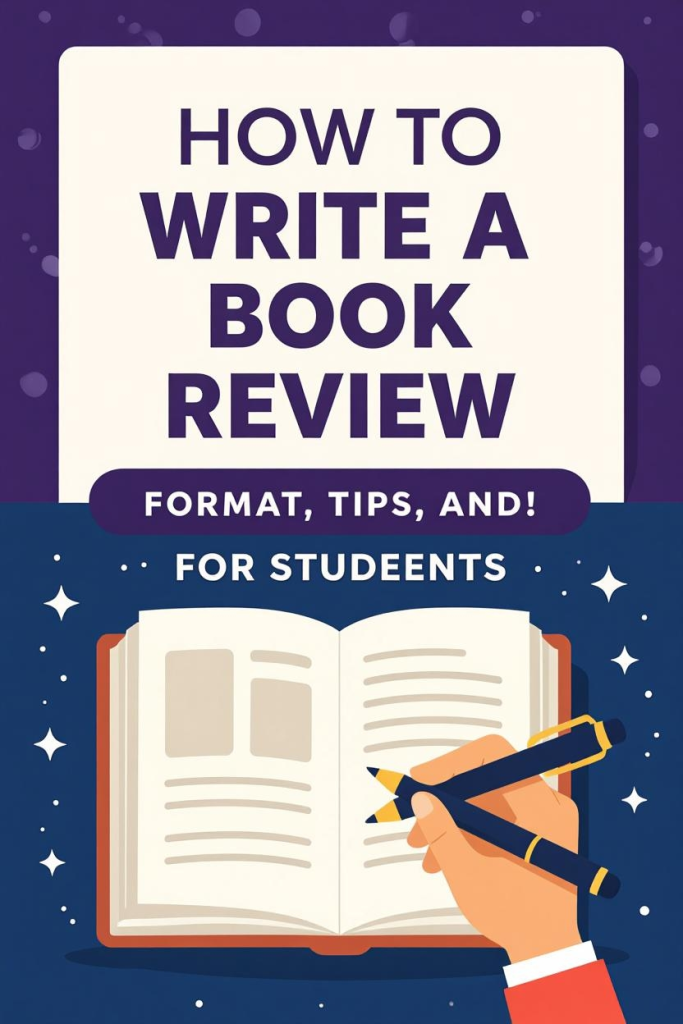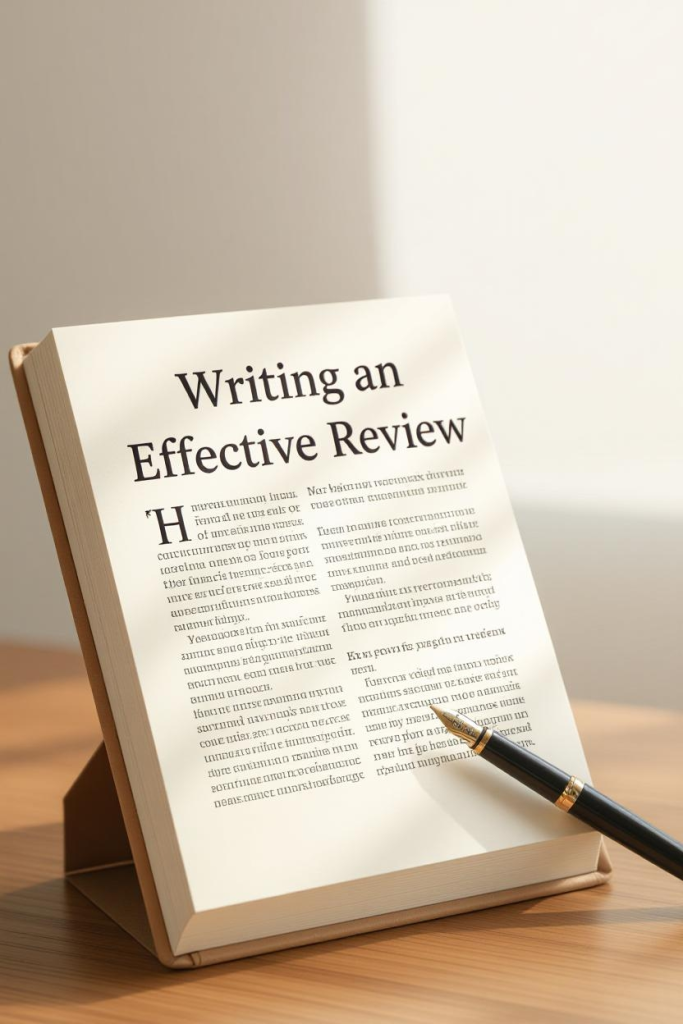
Writing a book review is one of the most common assignments students face in literature, history, and social science courses. Unlike a simple summary, a book review requires you to analyze, evaluate, and form a critical opinion about a text. Done well, it demonstrates both your understanding of the book and your ability to think critically.
📘 What Is a Book Review?
A book review is a critical evaluation of a book that goes beyond just summarizing its content. Instead of retelling the story or listing the main points, a review analyzes the author’s purpose, ideas, style, and impact, and gives an informed opinion about the book’s value.
When learning how to write a book review, it’s important to recognize that it is not the same as a book report. A report simply recounts events or lists characters, while a review requires deeper analysis. In a book review, you evaluate the content, interpret the author’s writing style, and weigh the book’s strengths and weaknesses. The purpose is to encourage critical thinking and help readers decide whether the book is worth their time. Many students, as Essayassits.com notes, often mistake a review for a summary—but a strong review demands insight, reflection, and structure. In this guide, we’ll walk you step by step through the process: choosing a focus, developing a thesis statement, building body paragraphs, and delivering a thoughtful final evaluation.
Pre-Writing: Reading and Taking Notes
Before you can write a strong book review, you need to start with the right preparation. The quality of your review depends heavily on how you read and what notes you take along the way. This stage might feel slow, but it lays the foundation for a clear thesis, strong arguments, and a polished final draft.
📚 Read with Purpose
Reading for a book review isn’t the same as reading for fun. Instead of just moving through the pages, approach the book with questions in mind:
- What is the author’s main argument or message?
- How does the author’s writing style help or weaken the story/ideas?
- What role does the historical or cultural context play?
- How does this book compare to others in the same field or genre?
Keeping these questions in mind makes your reading more active and focused.
📝 Active Reading Techniques
To go beyond surface-level reading, use these strategies:
- Highlight key passages – especially quotes that capture the author’s argument or tone.
- Take margin notes – jot down immediate reactions, questions, or surprises.
- Record themes – keep track of recurring ideas or motifs.
- Note weaknesses – such as confusing arguments, underdeveloped characters, or structural issues.
- Write reflections – how did the book challenge your assumptions or change your perspective?
These notes will later become evidence in your review.
✅ Note-Taking Checklist
Here’s a simple checklist to guide your notes:
- Title, author, and bibliographic information.
- The book’s central argument or purpose.
- Recurring themes or patterns.
- Author’s tone and writing style.
- Any shifts in your opinion as you read.
- Memorable quotes or examples.
- Connections to other works or topics you’ve studied.
💡 Why Pre-Writing Matters
http://essayassits.comSkipping this step often leads to vague, summary-heavy reviews. Careful reading and note-taking ensure that your review is analytical, not descriptive. You’ll be able to back up your claims with examples, build a strong thesis, and write a review that feels both insightful and credible.
👉 Up next: Once you’ve got your notes, the next step is to create an outline and develop your thesis statement—the backbone of your review.
Would you like me to make this section part of a full series-style blog guide (like Chapter 1: Pre-Writing, Chapter 2: Thesis & Outline, etc.), so students can follow step by step?
Need More Writing Assistance?

Order you first paper and join Essyassits.com club to receive discounts and updates. Try Essayassits.com
🖋️ Crafting Your Thesis and Book Review Outline
After you’ve finished reading and taking notes, the next crucial step in writing a book review is shaping your thesis statement and building a clear outline. Think of this stage as designing the blueprint for your review: without it, your ideas may come across as scattered or unfocused.
🎯 What Is a Thesis Statement in a Book Review?
A thesis statement is your main opinion about the book, expressed in one or two sentences. It should tell the reader:
- Your overall evaluation (positive, negative, or mixed).
- The main reasons why you feel this way.
This statement sets the tone for your review and gives your writing direction.
Example Thesis Statements
- “While J.K. Rowling’s Harry Potter and the Philosopher’s Stone captures the magic of childhood imagination, its predictable plot structure limits its literary depth.”
- “Michelle Obama’s Becoming succeeds as an inspiring memoir because of its honesty, accessible style, and reflections on leadership and identity.”
🗂️ Building a Book Review Outline
A good outline keeps your review organized and ensures you cover all the essential points without slipping into a simple summary.
Basic Outline Structure:
1. Introduction
- Title, author, and publication details.
- Brief context (genre, historical background, or author info).
- Thesis statement (your main judgment).
2. Summary (short!)
- A concise overview of the main argument, theme, or plot.
- Avoid excessive detail—just enough to support your critique.
3. Critical Analysis (main body)
Break this into focused paragraphs:
- Themes/Arguments – Were they convincing?
- Writing Style – Clear, engaging, or confusing?
- Characters (if fiction) – Believable and developed, or flat?
- Structure/Organization – Did the book flow logically?
- Relevance/Context – How does it fit in its genre or subject area?
4. Conclusion
- Restate your thesis in fresh words.
- Summarize your main points.
- Offer a recommendation: Who should (or shouldn’t) read this book?
🧭 Why This Step Matters
Jumping straight into writing without a thesis or outline often results in a review that feels like a plot summary rather than a critical evaluation. By creating a roadmap, you’ll stay focused, support your opinions with evidence, and present a review that is clear, balanced, and persuasive.
👉 Next up: With your thesis and outline ready, it’s time to start writing—beginning with a strong introduction that hooks your readers.
Would you like me to also create a ready-to-use fill-in-the-blank outline template students can
Check out Essayassits.com – pay someone to do my essay or get inspired by real book review examples, including sample book review and book review essay example templates.
Time to Write: Book Review Introduction
Now that you’ve read actively, taken notes, and built your outline, it’s time to start writing your book review. And like any strong essay, it all begins with an introduction.
Your introduction is the first impression you make on your reader. It should immediately provide key information about the book while also showing your perspective. A weak intro risks sounding like a report, while a strong one grabs attention and sets up your thesis.
Example Opening:
In her debut novel, Memory’s Edge, Lisa Tran explores how memory shapes identity through a gripping dystopian narrative. Drawing from her background in neuroscience, the author offers a compelling story that challenges readers’ assumptions about truth and perception. Though the book’s pace falters in parts, it ultimately delivers a thought-provoking message. For more on how to write a book title in an essay, visit Essayassist.com guide.
Summarize the Content
Then your summary should briefly describe the main premise, key characters, and themes, without revealing spoilers.
- This section supports your critical analysis, not replaces it. Focus on common features like the author’s argument, structure, or how the book helped advance a topic.
- Draw comparisons with other works only if they provide crucial details that enrich your review!
Analyze and Evaluate the Book
Once you’ve introduced the title, presented a concise summary, and crafted a clear thesis statement, it’s time to dive into the heart of your review: the critical analysis. A strong book review format includes multiple body paragraphs, each exploring a distinct element such as themes, writing style, or character development (in fiction). Your task is to critically evaluate the contents and the author’s ideas in a balanced fashion, supporting your points with specific examples.
Paragraph 1: Themes and Argument
Start with the central theme. Did the author support their ideas with convincing evidence? Was the logic coherent?
Example: Tran’s exploration of memory as a tool of state control is deeply unsettling yet timely. Through her protagonist’s unreliable recollections, the author raises questions about personal truth vs. political narrative – an argument supported by chilling flashbacks and symbolic imagery.
Paragraph 2: Writing Style and Structure
Next, evaluate the writing style and author structure. Consider the clarity, tone, and how well the narrative flows.
Example: The prose is lyrical but sometimes overwrought, distracting from the narrative tension. However, Tran’s non-linear structure mirrors the protagonist’s fragmented psyche, enhancing the reader’s immersion.
Paragraph 3: Characterization (for Fiction)
If you analyze the fiction, assess character development. Are the characters believable and consistent?
Example: While the protagonist’s arc is well-developed, supporting characters feel underwritten, particularly Juno, whose political persuasion and emotional depth are barely explored.
Paragraph 4: Context and Relevance
Consider the historical background, personal history, or how the book fits within the genre or works by the same author. Does it address the intellectual interests of the intended audience?
Example: Readers familiar with dystopian literature will recognize nods to Orwell and Atwood, though Tran offers a fresh lens rooted in Southeast Asian political history. Each paragraph in your book review layout should clearly support your evaluation, which should be grounded in analysis rather than personal bias.
Conclusion of the Review
After presenting your analysis, it’s time to wrap up your book review with a clear and thoughtful conclusion. Many students underestimate this part, but the conclusion is your last chance to leave an impression on your readers. It’s where you tie everything together and provide your final judgment.
Example conclusion: Ultimately, Memory’s Edge is a haunting, if occasionally uneven, debut that challenges readers to question the reliability of personal truth. Though some character arcs feel underdeveloped, Tran’s sharp commentary and unique structural choices make this a standout in the dystopian genre. I recommend it to readers intrigued by psychological fiction and complex political narratives.
Revising and Proofreading
You’ve written your book review, but you’re not finished yet. The final and equally important stage is revising and proofreading. This step ensures that your work is clear, polished, and professional—because even the best ideas lose their impact if they’re hidden under errors or clunky wording.
Did you check if:
- Is the thesis clearly restated in the conclusion?
- Are quotes attributed correctly?
- Does each paragraph support the overall analysis?
- Are spelling, punctuation, and grammar error-free?
- Does the review follow the appropriate book review format?
Revising strengthens your review and prepares it for submission or publication as a model book review example.
🌟 Tips & Common Mistakes: Writing an Effective Book Review

Writing a book review can be both exciting and challenging. To make sure your review stands out, it’s important to know not only the best practices but also the common pitfalls students often fall into. Here’s a guide to help you strengthen your review and avoid errors that weaken your credibility.
✅ Top Tips for Writing a Strong Book Review
- Be Balanced – Highlight both strengths and weaknesses. A fair review is more persuasive than one that’s overly critical or blindly positive.
- Support Your Claims – Always back up your opinions with evidence (specific quotes, examples, or moments from the book).
- Stay Focused – Keep your writing centered on analysis, not retelling the story.
- Use Clear, Academic Language – Write in a professional yet engaging tone. Avoid slang or overly casual phrasing.
- Know Your Audience – Think about who might read the book. Is it best for students, researchers, or casual readers?
- Practice Critical Thinking – Go beyond “I liked it” or “I didn’t like it.” Ask why the book succeeded or failed in its purpose.
❌ Common Mistakes to Avoid
- Writing a Summary Instead of a Review
- Many students simply retell the plot. Remember: a review analyzes, not just summarizes.
- Skipping the Thesis Statement
- Without a clear thesis, your review may feel directionless. Always state your main evaluation early on.
- Ignoring the Author’s Purpose
- A book review should consider what the author intended to achieve and whether they succeeded.
- Being Overly General
- Phrases like “the book was good” or “the writing was bad” are too vague. Be specific—what made it good or bad?
- Poor Organization
- Jumping between random points confuses the reader. Use an outline to structure your thoughts.
- Neglecting Revision
- Even a brilliant analysis loses impact if filled with grammar mistakes and unclear sentences.
An effective book review is more than just an opinion—it’s a thoughtful evaluation backed by evidence and presented with clarity. By following the tips above and avoiding common mistakes, you’ll craft reviews that are not only insightful but also enjoyable to read..
| Tips for an Effective Review | Common Pitfalls to Avoid |
| Always provide evidence for claims to support your points clearly and persuasively. | Avoid vague statements like “It was good” without explanation or proof. |
| Balance critique with fairness – mention both strengths and weaknesses. | Don’t focus only on flaws or blindly praise without offering a thoughtful evaluation. |
| Keep the intended readers in mind – write in a tone and style appropriate for readers of the target audience. | Avoid writing too casually or using slang in an academic context. |
| Avoid excessive summarizing – a concise overview is enough to support your review. | Don’t retell the entire story; this is not a report. |
| Use specific language – cite examples or quotes when analyzing themes or the author’s arguments. | Generalizations like “It was interesting” lack depth and don’t help readers understand the book’s value. |
| Refer to book review examples to see how professional critics structure effective reviews. | Don’t copy structure blindly – adapt your format to the assignment’s goal and perspective. |
| Use a clear book review structure with an intro, analysis, and conclusion. | Avoid writing in a disorganized or stream-of-consciousness style. |
| Know how to format a book review using proper citations and consistent style. | Don’t skip bibliographic information or forget to cite the work properly. |
We are sure that with all the tips wrapped together, your review will be critical, precise, and especially interesting! Enjoy writing book reviews, and remember that Essayassits.com is always there to help you with academic struggles!
Frequently Asked Questions (FAQ)

What’s the Difference Between a Book Review and a Report?
A book review analyzes the author’s argument, style, and impact, whereas a report just summarizes. A good review offers critique, not just content.
How Do I Start a Book Review Essay?
Begin with the book’s title, author, and context. Then hook the reader and state your main opinion (thesis). For ideas, check out how to start a book review essay sample.
What’s the Correct Structure for a Book Review?
Use this format: introduction, brief summary, critical analysis, and conclusion. Follow a clear review structure or sample book review layout.
What Mistakes Should I Avoid?
Don’t summarize too much, use vague language, or skip formatting. Always provide evidence and stay organized.
Where Can I Find a Sample or Template?
Check Essayassits.com for book review examples and any book review template for adults.
